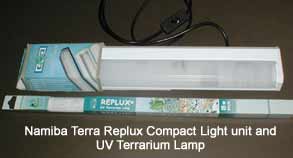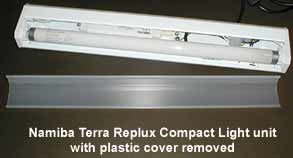|
Summary
We
have found that some of the plastic covers used over UVB tubes
in Namiba Terra Replux Compact Light units (Namiba Terra GmbH
- www.namibaterra.de) block over 99% of the UVB and most of
the UVA. When one of these covers is
placed over the tube it is instantly rendered useless as a
source of UVA or UVB.
Introduction
Recently, we were asked to test a new European product
which a British distributor was considering introducing to
the UK market: a UVB fluorescent tube in a compact lamp unit
supplied with a translucent plastic cover.
The lamps
sent for testing were two brand new Namiba
Terra Replux Fluorescent Tubes, size 15watt, length
18”, and two brand new Namiba Terra
Replux Compact Lights, each of which consists of a
metal frame enclosing a ballast and fittings for the 18” tube,
plus a removable plastic translucent clip-on cover.
Fig. 1
shows one of the Compact Lights and one of the tubes, in their
original packaging. Fig. 2 shows the fluorescent tube installed
in the lamp unit, with the plastic cover which then clips
over the front of the lamp.
We set
up the tubes in the units, and took recordings of the UVB
output of the lamps, with and without the plastic cover in
place, using the Solarmeter Model 6.2 UVB manufactured by
Solartech Inc. (www.solarmeter.com)
We then
took a series of readings with the Ocean Optics Inc. USB 2000
Fibre Optic Spectrometer, (www.oceanoptics.com), again with
and without the plastic cover in place.
Results.
UVB
Meter Readings
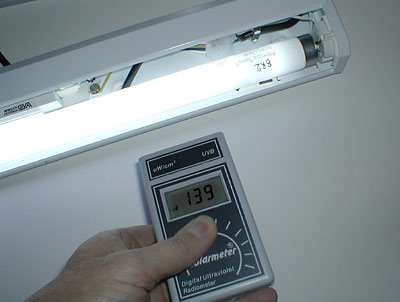 |
|
UVB
Output (uW/cm2) of two Namiba Terra Replux Fluorescent
Tubes in Compact Light Units
|
|
Distance
from surface of tube (inches)
|
Tube
1 with no cover
|
Tube
1 with plastic cover
|
Tube
2 with no cover
|
Tube
2 with plastic cover
|
|
2"
|
122
|
1
|
118
|
1
|
|
4"
|
66
|
0
|
65
|
0
|
|
6"
|
43
|
0
|
43
|
0
|
|
8"
|
31
|
0
|
31
|
0
|
|
10"
|
22
|
0
|
22
|
0
|
|
12"
|
17
|
0
|
17
|
0
|
|
14"
|
14
|
0
|
14
|
0
|
|
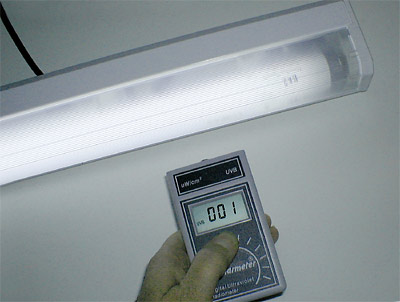 |
The
direct readings without the plastic cover show clearly
that this is a normal type of UV-emitting fluorescent
tube. The readings show how the output of a UVB fluorescent
lamp decreases steadily as the distance increases from
the lamp’s surface. These brand new lamps (after 30 minutes
warm-up time) are both emitting 43 uW/cm² at 6ins and
17 uW/cm² at 12ins. This is an output similar to those
we have seen with other UVB fluorescent tubes of this
style. However, once the cover was put into place, the
readings dropped to zero at all distances except 2” when
a single microwatt per cm² was recorded. This plastic
cover is an extremely effective UVB blocker. If one microwatt
penetrates, when the unfiltered recording at 2” is 122uW/cm²,
this indicates a 99.2% block. |
Spectrometer
Readings
To make
the spectrogram easier to understand, a representation of
the electromagnetic spectrum, to the same scale, is shown
underneath. The recording from the tube with no plastic cover
is shown in blue; the recording with the plastic cover over
the tube is in red.
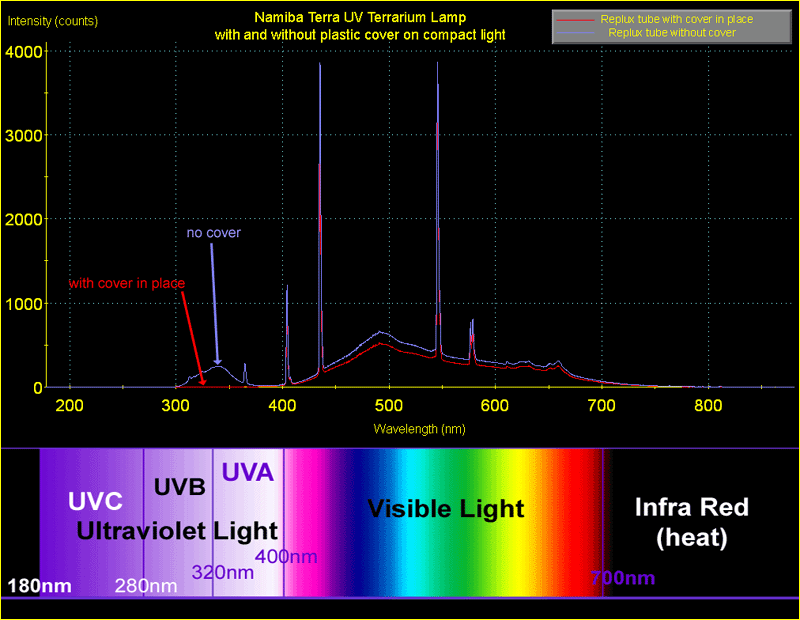
Spectrogram
2 shows a recording made at a higher integration time – this
increases the sensitivity of the spectrometer, enhancing the
recording of just the UV wavelengths (290 – 400nm)
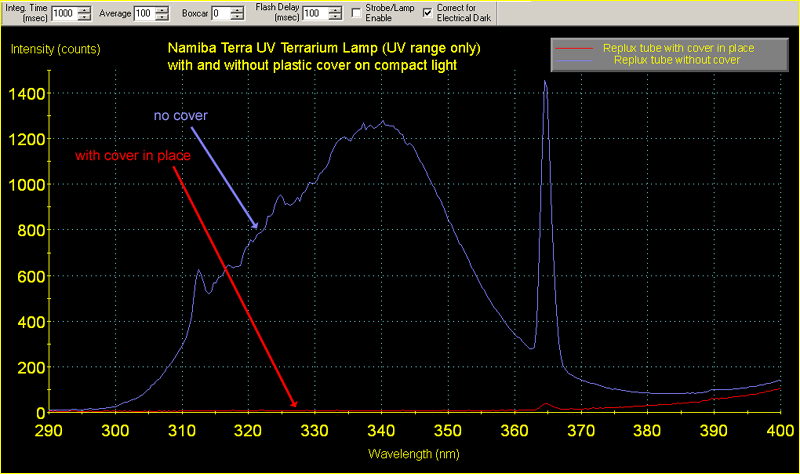
These
spectrograms confirm the readings taken with the Solarmeter
UVB meter. The fluorescent tube without the plastic cover
has a spectrogram absolutely typical of UV-emitting tubes
of this type. The mercury vapour emission spectrum produces
intense “spikes” of light at distinct wavelengths (e.g., the
peak at 365nm in the UVA range) and the mix of phosphors provide
more evenly distributed light across the entire spectrum from
UVB to infra-red, with the highest peak in the blue wavelengths
at around 490nm. In
the UV range, the lamp emits UV from about 295nm (in the UVB
range) with a maximum at around 340nm (in the UVA range).
However,
the change in the spectrum when the cover is applied is dramatic.
The cover almost completely blocks transmission of all wavelengths
below about 365nm; almost nothing at all is recorded in the
UV region of the spectrum.
This
plastic is effectively blocking UVB and all but the highest
wavelength UVA, whilst allowing visible light to pass much
more freely through.
Further
tests were carried out. We recorded the output of the fluorescent
tubes during a standard 105-hour burn-in period. We also conducted
a transmission test using the spectrometer, comparing the
UV transmission of the plastic cover with that of glass and
of a sheet of UV-transmitting acrylic. The full report is
available upon request.
The
problem
The
packaging on this product states, “Namiba compact lights can
be used equipped with Replux fluorescent tubes… so that the
UV radiation can arrive without reduction at the animal. The
transparent plastic cover is made of an UV-permeable special
plastic and is suitable therefore for the safe installation
by UV tubes in the Terrarium”
Unfortunately,
the transparent cover appears to be the absolute opposite
to this – it blocks over 99% of the UVB.
When
the cover is placed over the tube it is instantly rendered
completely useless as a source of UVA or UVB.
Comments
and recommendations
We
contacted Namiba Terra GmbH immediately, and sent them a full
report of our findings.
We
have now had a reply from the President of the company, Paul
Lutz Weynans.
He told us that they have now discovered that their manufacturer
had changed the plastic cover and had not been using the UV
permeable plastic which they had ordered.
He wrote that they had found that even the correct type of
plastic reduced the output of UV by 30 - 40%, and so they
were not satisfied with this type of cover.
He added that they are now working on a stainless steel "net"
to replace the cover, and he offered to inform us when this
was in production.
We
asked whether the company were considering recalling the faulty
product, or informing their distributors and customers of
the problem with the plastic. However, we have not, as yet,
received their reply. When we do, we will be pleased to publish
details here on their behalf.
UPDATE:
November 2006. We have heard nothing more. The product
is still available from the Namiba Terra website. The
illustrations in English no longer include a caption saying
the acrylic allows UVB light through; however this claim is
still made on the German listings.
We
believe the implications are very serious.
Every reptile that is currently relying on these UVB lamps
for its vitamin D3 synthesis, in whatever country these have
been on sale, is now at risk of developing vitamin D deficiency
and possibly metabolic bone disorder if the plastic cover
has been fitted over the tube.
Metabolic bone disorder develops very slowly over several
months; owners will not see any illness in an affected reptile
for a very long period as the bone disease develops. However,
once the bones are weakened and deformities appear, it may
be too late to effect a complete cure.
Owners
of these lamps must be informed of the situation.
All
that is needed, to ensure that the reptiles are no longer
at risk, is for the owners to remove the covers from their
lamps at once.
This
does, however, expose the ballast and its wiring; care must
be taken to ensure that the reptile cannot gain access to
this part of the lamp.
Provided
that the lamp is sited suitably close to the reptile’s basking
spot (we usually recommend a distance of 8 – 10 inches above
the reptile’s back, for this type of fluorescent tube) the
reptile will begin to obtain UVB light for vitamin D3 synthesis.
|


















